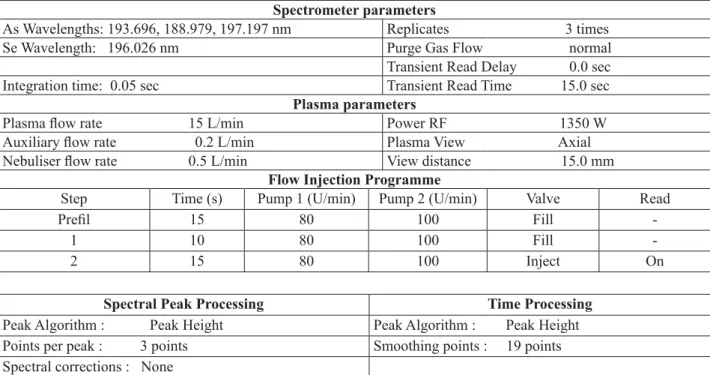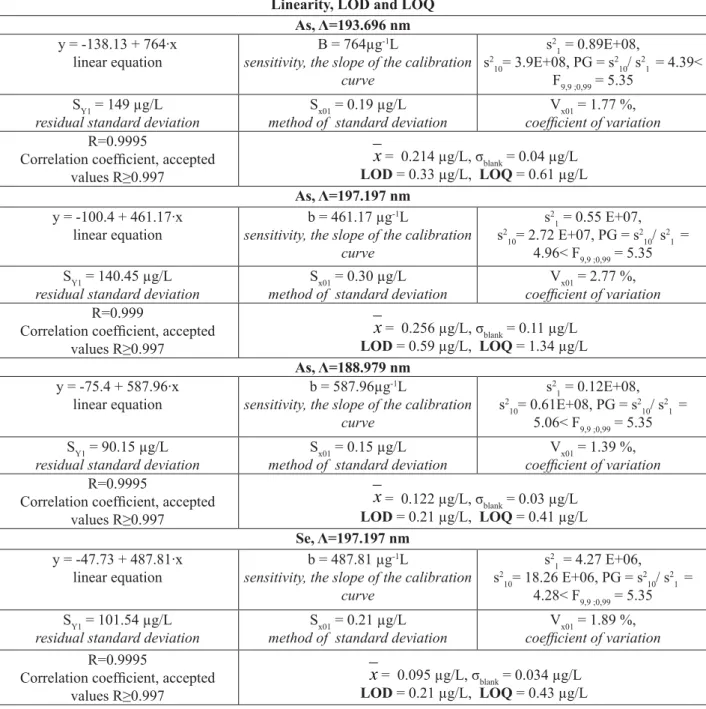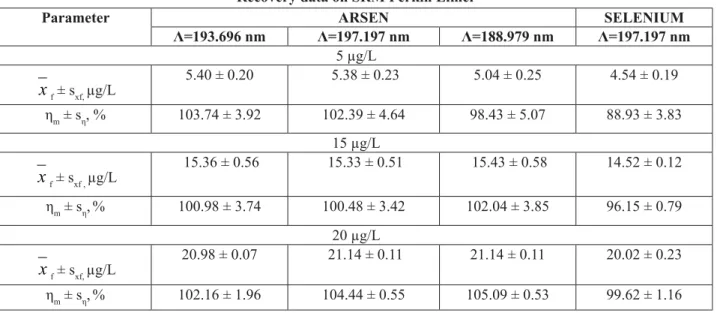FLOW INJECTION ANALYSIS SYSTEM COUPLED WITH ICP-EOS FOR
DETERMINATION OF SOME METALLIC ELEMENTS IN
DRINKING WATER
Cristina Dinu*, Gabriela Vasile, Liliana Cruceru, Jana Petre
National Research and Development Institute for Industrial Ecology ECOIND, 90-92 Road Panduri, Bucharest, e-mail: ecoind@incdecoind.ro
Abstract: The European Drinking Water Directive (98/83/EC), transposed in Romanian Legislation as Low 458/2002, amended by Low 311/2004, imposes the limit of concentration for metallic elements in water intended for human consumption. The toxic metals arsenic and selenium are among these elements and the limit value is 10
μg/L. In the paper there are presented the working conditions for determination of As and Se from drinking water using modern techniques based on the fl ow injection-hydride generation with the inductively coupled plasma atomic emission spectrometry (FIAS-ICP-EOS). The analyses were performed on Optima 5300 DV Perkin Elmer equipment with FIAS 400 Flow Injection System, Perkin Elmer type. For the hydride generation two types of solution were used: 10% (v/v) HCl as a carrier solution and 0.2 % NaBH4 in 0.05%NaOH solution as a reducing agent [1]. The treatment step of the samples and standard solutions consisted in reducing with mixed solutions of KI and ascorbic acid in acidic condition (HCl) for As and only with HCl and high temperature for Se [2,3]. The paper contains the characteristic parameters of the methods, such as: low detection limit, quantifi cation limit, repeatability, precision, recovery, which were evaluated using Certifi ed Reference Materials for each element.
Keywords: drinking water, As, Se, hydride analyses, ICP-EOS.
Introduction
Nowadays the determination of trace elements in drinking water is a matter of real interest because of the role of water in the human metabolism and the consequences of ingestion for human health. The European Drinking Water Directive (98/83/EC), transposed in Romanian Legislation as Low 458/2002, amended by Low 311/2004, imposes the limits of concentration for metallic elements in water intended for human consumption. The toxic metals arsenic and selenium are among these elements and the limit value is 10 μg/L.
Arsenic may be found in water which has fl owed through arsenic-rich rocks. Severe health effects have been observed in populations drinking arsenic-rich water over long periods, in countries worldwide. Chronic arsenic poisoning, as occurs after long-term exposure through drinking water is very different to acute poisoning. Immediate symptoms of an acute poisoning typically include vomiting, oesophageal and abdominal pains, and bloody “rice water” diarrhoea. Chelation therapy may be effective in acute poisoning but should not be used against long-term poisoning. Long-term exposure to arsenic via drinking-water causes cancer of the skin, lungs, urinary bladder, and kidney, as well as other skin changes such as pigmentation changes and thickening (hyperkeratosis). Increased risks of lung and bladder cancer as well as arsenic-associated skin lesions have been observed at drinking-water arsenic concentrations of less than 0.05 mg/L. Absorption of arsenic through the skin is minimal and thus hand-washing, bathing, laundry, etc. with water containing arsenic do not pose human health risk [4].
Selenium is toxic within large amounts, but trace amounts of it are necessary for the cellular function in most, if not all, animals, forming active centres of the enzymes glutathione peroxidase and thioredoxin reductase. Although selenium is an essential trace element, it is toxic if taken in excess. Exceeding the Tolerable Upper Intake Level of 400 micrograms per day can lead to selenosis [5]. Symptoms of selenosis include a garlic odour on the breath, gastrointestinal disorders, hair loss, sloughing of nails, fatigue, irritability and neurological damages. Extreme cases of selenosis can result in cirrhosis of the liver, pulmonary oedema and death [5]. Elemental selenium and most metallic selenides have relatively low toxicities because of their low bioavailability. By contrast, selenates and selenites are very toxic, having an oxidant mode of action similar to that of arsenic trioxide. The chronic toxic dose of selenite for human beings is about 2400 to 3000 micrograms of selenium per day for a long time [6]. Hydrogen selenide is an extremely toxic, corrosive gas. Selenium poisoning of water systems may result whenever new agricultural runoff courses through normally dry undeveloped lands. This process leaches natural soluble selenium compounds (such as selenates) into the water, which may then be concentrated in new “wetlands” as the water evaporates.
Accurate measurement of arsenic in drinking-water at levels relevant to health requires laboratory analysis, using sophisticated and expensive techniques and facilities while trained staff not easily available in many parts of the world. Analytical quality control and external validation remain problematic. Field test kits can detect high levels of these elements but are typically unreliable at lower concentrations of concern for human health.
LC-MS[16], HPLC-ICP-MS [17,18]. In the paper there are presented the working conditions for determination of As and Se from drinking water using modern techniques based on the fl ow injection-hydride generation with the inductively coupled plasma atomic emission spectrometry (FIAS-ICP-EOS). The methods applied with this modern technique have low detection limits (As – 0.21 ÷ 0.59 μg/L, Se – 0.21 μg/L), situated under the limit values imposed by legislation. Experimental Section
Apparatus: Flow Injection Hydride Generation System FIAS 400 with Inductively Coupled Plasma Optical Emission Spectrometer ICP-EOS type Optima 5300 DV Perkin Elmer, Analytical Balance Kern ABT 220-50M, Bandelin Sonorex Water Bath (only heating function).
Reagents: Merck solution for calibration (1000 mg As/L; 1000 mg Se/L, ICP standards), 100 mg/L multielement Perkin Elmer SRM, hydrochloric acid ( 37%, Merck quality), potassium iodide (99,995% purity, Merck quality), L-ascorbic acid (>99%, Sigma-Aldrich quality); sodium borohydride (>96%, Merck quality), sodium hydroxide (pellets, Gr for analysis, Merck quality), argon 99,996% purity, nitrogen 99,999% purity (Linde-Gas quality), ultrapure water.
Procedure: The water samples (drinking water, groundwater, surface water) and standard solutions for As and Se determinations should be pre-reduced prior the analysis (table 1). For each set of standards a blank sample using the same procedure was prepared. For the hydride vapour generation two types of solution were used: 10% (v/v) HCl as a carrier solution and 0.2 % NaBH4 (w/v) in 0.05%NaOH (w/v) solution as a reducing agent, which should be freshly prepared.
Table 1
Pre-treatment step for the As and Se determinations with FIAS-ICP-EOS
Element Reduction Pre-treatment procedure for each standard
solution and sample
As As5+ to As3+ 5 mL 5% (w/v) potassium iodide and 5% (w/v) ascorbic acid, 45 minutes at room temperature.
Se Se6+ to Se4+ 2 mL HCl concentrated, heated on a water bath at 90ºC for 20 minutes. The operational parameters for the spectrometer, plasma, FIAS and data processing are presented in Table 2.
Table 2
Parameters for FIAS-ICP-EOS Spectrometer parameters
As Wavelengths: 193.696, 188.979, 197.197 nm Replicates 3 times Se Wavelength: 196.026 nm Purge Gas Flow normal Transient Read Delay 0.0 sec Integration time: 0.05 sec Transient Read Time 15.0 sec
Plasma parameters
Plasma fl ow rate 15 L/min Power RF 1350 W Auxiliary fl ow rate 0.2 L/min Plasma View Axial Nebuliser fl ow rate 0.5 L/min View distance 15.0 mm
Flow Injection Programme
Step Time (s) Pump 1 (U/min) Pump 2 (U/min) Valve Read
Prefi l 15 80 100 Fill
-1 10 80 100 Fill
-2 15 80 100 Inject On
Spectral Peak Processing Time Processing Peak Algorithm : Peak Height Peak Algorithm : Peak Height Points per peak : 3 points Smoothing points : 19 points Spectral corrections : None
system of the equipment. The purity of all reagents used is critical when determining low levels of hydride elements. Table 1 summarizes preceding treatments for the As and Se determinations with FIAS-ICP-EOS.
ICP-EOS uses specifi c wavelengths to detect metallic elements; the methods applied with this equipment are perfectly able to measure accurately an analyte in the presence of interferences.
In order to evaluate the performances of the methods some standard solutions for As and Se using Certifi ed Reference Material (1000 mg/L, Certipur ICP Standard, traceable to SRM from NIST) were prepared during the experimental tests. For the recovery test a multielement SRM type Perkin Elmer Quality Control Standard 21 was used, with 100 mg/L As and Se. To establish the performance parameters of the methods, the tests indicated in Table 3 were performed.
Table 3
Performed tests used for performance parameters of the methods Linearity LOD and LOQ Test for the homogeneity
of the variance
Repeatability precision, recovery
10 standard solutions between 2 μg/L ÷ 20 μg/L
1 mL; 2 mL; 3 mL; 4 mL; 5 mL; 6 mL; 7 mL; 8 mL; 9 mL and 10 mL from 0.1 mg/L to 50 mL with 10% HCl.
10 independent blank solutions measured each of them once.
- 10 independent standard solutions of 2 μg/L concentration;
- 10 independent standard solutions of 15 μg/L concentration.
- 10 independent standard solutions of 20 μg/L concentration.
- 5 independent standard solutions of 5 μg/L, 15 μg/L and 20 μg/L concentrations (Perkin Elmer QCS 21). The mathematical relations and the admissible range or value for some important parameters, such as: bias, coeffi cient of variation (relative standard deviation) and recovery are presented in Table 4.
Two aspects are important for Internal Quality Control: the analysis of “control materials”, such as CRM or spiked samples, to monitor the trueness (recovery) and replication of analysis to monitor the precision. Both aspects form a part of statistical control, a tool for monitoring the accuracy of an analytical system. Recovery studies were performed to the same matrix type (drinking water) at different levels of analyte concentration [19].
Table 4
Mathematical equations used for evaluation of recovery, precision and bias Recovery, %
η
(%) =x
x
x
a b f
−
100, %,
x
f = mean value of fortifi ed samples, μg/L;x
b = mean value of unfortifi ed samples, μg/L;x
a = concentration of added standard solution, μg/L. For 10 μg/L mean recovery = 60-115% [20,22]Bias, %
Bias =
−
×
100
x
x
x
a a f
, %
Bias value < t(99,9 ) =2.82 [21,22]
Relative standard deviation, %
RSD =
×
100
x
s
r, Sr = standard deviation of
concentrations, μg/L;
x
= mean value of concentrations, μg/L. for 10 μg/L, acceptable RSDvalues:
Horwitz, 22.6 -33 %; AOAC Peer Verifi ed Methods, 15
-21% [20,22]
Results and discussion
The working range for As and Se determination using FIAS-ICP-EOS is linear between 2 and 20 μg/L for all tested wavelengths. In the tests for the homogeneity of the variance, PG values are lower than Fischer-Snedecor’s “F” value. The values of coeffi cient of variation (As: 1.77% for λ=193.696 nm, 2.77% for λ =197.197 nm and 1.39% for
Table 5
Linearity, LOD and LOQ As, Λ=193.696 nm y = -138.13 + 764·x
linear equation
B = 764μg-1L
sensitivity, the slope of the calibration curve
s2
1 = 0.89E+08, s2
10= 3.9E+08, PG = s 2
10/ s 2
1 = 4.39< F9,9 ;0,99 = 5.35
SY1 = 149 μg/L
residual standard deviation
Sx01 = 0.19 μg/L
method of standard deviation
Vx01 = 1.77 %,
coeffi cient of variation
R=0.9995
Correlation coeffi cient, accepted values R≥0.997
x
= 0.214 μg/L, σblank = 0.04 μg/L LOD = 0.33 μg/L, LOQ = 0.61 μg/L As, Λ=197.197 nmy = -100.4 + 461.17·x linear equation
b = 461.17 μg-1L
sensitivity, the slope of the calibration curve
s2
1 = 0.55 E+07, s2
10= 2.72 E+07, PG = s 2
10/ s 2
1 = 4.96< F9,9 ;0,99 = 5.35 SY1 = 140.45 μg/L
residual standard deviation
Sx01 = 0.30 μg/L
method of standard deviation
Vx01 = 2.77 %,
coeffi cient of variation
R=0.999
Correlation coeffi cient, accepted values R≥0.997
x
= 0.256 μg/L, σblank = 0.11 μg/L LOD = 0.59 μg/L, LOQ = 1.34 μg/L As, Λ=188.979 nmy = -75.4 + 587.96·x linear equation
b = 587.96μg-1L
sensitivity, the slope of the calibration curve
s2
1 = 0.12E+08, s2
10= 0.61E+08, PG = s 2
10/ s 2
1 = 5.06< F9,9 ;0,99 = 5.35 SY1 = 90.15 μg/L
residual standard deviation
Sx01 = 0.15 μg/L
method of standard deviation
Vx01 = 1.39 %,
coeffi cient of variation
R=0.9995
Correlation coeffi cient, accepted values R≥0.997
x
= 0.122 μg/L, σblank = 0.03 μg/L LOD = 0.21 μg/L, LOQ = 0.41 μg/L Se, Λ=197.197 nmy = -47.73 + 487.81·x linear equation
b = 487.81 μg-1L
sensitivity, the slope of the calibration curve
s2
1 = 4.27 E+06, s2
10= 18.26 E+06, PG = s 2
10/ s 2
1 = 4.28< F9,9 ;0,99 = 5.35 SY1 = 101.54 μg/L
residual standard deviation
Sx01 = 0.21 μg/L
method of standard deviation
Vx01 = 1.89 %,
coeffi cient of variation
R=0.9995
Correlation coeffi cient, accepted values R≥0.997
x
= 0.095 μg/L, σblank = 0.034 μg/L LOD = 0.21 μg/L, LOQ = 0.43 μg/LIn fi gures 1 and 2 the evolutions in time of peak height for As (Λ=193.696 nm) and Se are presented. The method
The Bias values are situated under the limit value for both elements and all wavelengths. The limit value is 2.82% for 99% confi dence level and 9 freedom degrees. For 10 μg/L level of concentration, the recovery percentage must be
situated within 60 and 115 % range. In the Tables 6 and 7 all the obtained values of recovery percentage for different types of standard solutions respect needed requirement.
Table 6
Precision and bias data on SRM Merck
Parameter ARSEN SELENIUM
Λ=193.696 nm Λ=197.197 nm Λ=188.979 nm Λ=197.197 nm
RSDr, % 1.87 2.03 1.02 1.40
Bias, % 1.99 0.99 2.50 1.59
Table 7
Recovery data on SRM Perkin Elmer
Parameter ARSEN SELENIUM
Λ=193.696 nm Λ=197.197 nm Λ=188.979 nm Λ=197.197 nm 5 μg/L
x
f ± sxf, μg/L5.40 ± 0.20 5.38 ± 0.23 5.04 ± 0.25 4.54 ± 0.19
ηm ± sη, % 103.74 ± 3.92 102.39 ± 4.64 98.43 ± 5.07 88.93 ± 3.83 15 μg/L
x
f ± sxf , μg/L15.36 ± 0.56 15.33 ± 0.51 15.43 ± 0.58 14.52 ± 0.12 ηm ± sη,% 100.98 ± 3.74 100.48 ± 3.42 102.04 ± 3.85 96.15 ± 0.79
20 μg/L
x
f ± sxf, μg/L20.98 ± 0.07 21.14 ± 0.11 21.14 ± 0.11 20.02 ± 0.23
ηm ± sη,% 102.16 ± 1.96 104.44 ± 0.55 105.09 ± 0.53 99.62 ± 1.16
Conclusions
Single-laboratory validation is a valuable source of data usable to demonstrate the fi tness-for-purpose of an analytical method. Also, the statistical interpretation of the experimental results prove that the proposed methods applied with FIAS-ICP-EOS equipment can be successfully used for the analytical control of the As and Se from drinking water, groundwater and surface water. Arsenic determination can be performed at three different wavelengths, 193.696 nm, 197.197 nm and 188.979 nm, the experimental data showed small differences for the obtained performance parameters. Selenium can be determined at 197.197 nm.
References
Perkin Elmer, Inc., Flow Injection Mercury/Hydride Analyses. Recommended Analytical Condition and General [1].
Information, 2000, USA;
SR EN ISO 11969/2007: Water Quality. Determination of arsenic. Atomic absorption spectrometric method [2].
(hydride technique);
ISO 9965/1993: Water Quality. Determination of selenium. Atomic absorption spectrometric method (hydride [3].
technique);
World Health Organization, “Arsenic in drinking water”, 2001, Geneva, Switzerland; [4].
Gad, M.A.; Abd El-Twab, S.M.; Environmental Toxicology and Pharmacology 27, 2009; 7-16; [5].
Wilber, C.G., “Toxicology of selenium”, Chemical Toxicology, 1980, 17, 171-230; [6].
Niedzielski, P., Siepak, M., Siepak, J. and Przydryiek, J. Polish Journal of Environmental Studies. 2004; [7].
ISO 15586 /2003: Determination of trace elements using atomic absorption spectrometry by graphite furnace; [8].
Britta Planer-Friedrich, Corrine Lehr, Jorg Matschullat, Broder J. Merkel, Darrel Kirk Nordstrom and Mark W. [9].
Sandstrom; Geochimica et Cosmochimica Acta 70, 2006, 2480-2491;
SR EN ISO 11885/2008: Water quality. Determination of 33 elements by inductively coupled plasma atomic [10].
Henk J van de Wiel, National Institute of Public Health and the Environmental (RIVM). Netherlands. Determination [11].
of elements by ICP-AES and ICP-MS, sept. 2003;
lSO 17294 - 2/2002 •- Water quality - Application for ICP-MS. Part 2: Determination of 62 elements; [12].
EPA Method 6020A - 1998; Inductively coupled plasma - Mass spectrometry; [13].
Toniolo, R.; Tubaro, F.; Bin, S.; Pizzariello, A.; Susmel, S.; Dossi, N. and Bontempelli G.; Talanta 78, 2009; [14].
753-758;
Staniszewski, B. and Freimann, P.; Spectrochimica Acta Part B: Atomic Spectroscopy, Volume 63, Issue 11, [15].
2008; 1333-1337;
Zhang, B.; Zhou, K.; Zhang, J.; Chen, Q.; Guorong Lin; Shang, H.; Qin, W.; Pinglan Li and Lin, T.; Food [16].
Chemistry, Volume 115, Issue 2, 2009, 727-734;
Hua, L.; Nishida, M.; Fujiwara, A.; Yashiki, M.; Nagao,
[17]. M.and Namera, A.; Legal Medicine 11, 2008, 80-82;
Bauer,M.and Blodan, C.; Science of the Total Environment 354, 2006; 179-190; [18].
CITAC/Eurachem Guide: Guide for Quality in Analytical Chemistry – An Aid to Accreditation, 2002; [19].
I
[20]. Taverniers, I.; De Loose, M. and Bockstaele, E. V. Trends in Analytical Chemistry, 23 (8), 535, 2004; Hibbert
[21]. , D. B., Quality Assurance for the Analytical Chemistry Laboratory, Oxford, University Press, 2007; Tanase, I. Gh., Radu, G.L., Pana, A. and Buleandra, M., Analytical method validation, Printech Press, Bucharest, [22].



